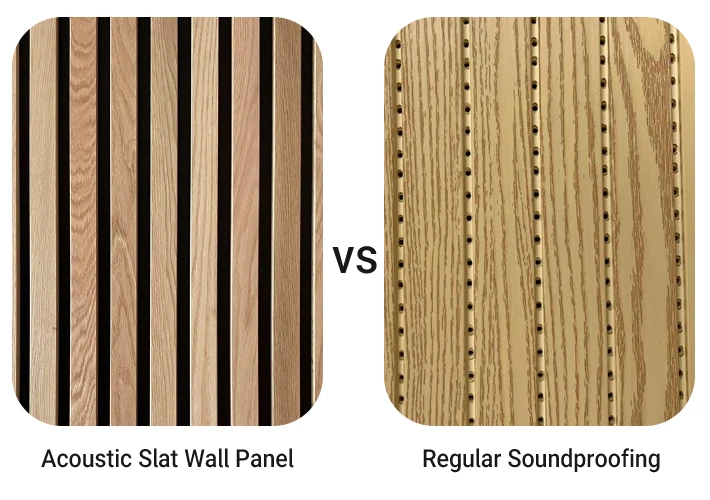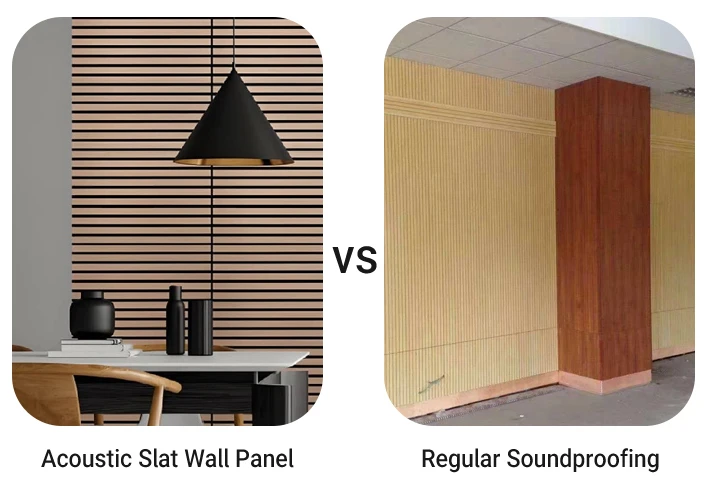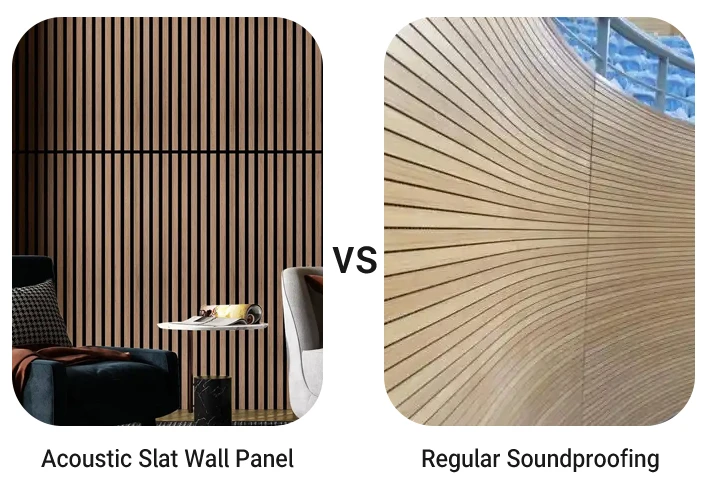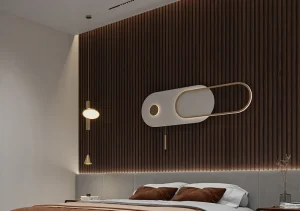Table of Contents
ToggleIntroduction
When it comes to creating the ultimate home theater experience, sound quality is just as important as the screen. While most homeowners invest heavily in high-resolution projectors, large displays, and comfortable seating, one area that is often overlooked is sound treatment. The two most common methods for improving audio performance are acoustic panels and soundproofing materials.
Although these terms are sometimes used interchangeably, they serve very different purposes. Home theater acoustic panels are designed to enhance the quality of sound inside a room, while regular soundproofing focuses on preventing sound from entering or escaping a space. For anyone planning a home theater setup—whether it’s a private cinema room or a multi-functional entertainment space—understanding the differences between these two approaches is essential.
In this article, we’ll explore the key differences between home theater acoustic panels and regular soundproofing, covering their functions, materials, benefits, and applications. By the end, you’ll know exactly which option (or combination of both) is best for your project.

What Are Home Theater Acoustic Panels?
Definition and Purpose
Acoustic panels are sound-absorbing materials designed to improve the acoustic quality within a room. They don’t stop sound from traveling outside the room but instead control how sound waves behave inside the space.
In a home theater, acoustic panels help reduce unwanted echo, reverberation, and standing waves, ensuring dialogue is crisp, music is clear, and sound effects are immersive.
Common Materials Used
- Fabric-wrapped fiberglass: Lightweight, durable, and highly effective at absorbing mid-to-high frequencies.
- Wood slat acoustic panels: Provide both aesthetic appeal and excellent acoustic performance.
- Foam panels: Affordable, easy to install, but less effective for lower frequencies.
- Bamboo charcoal wood veneer panels (modern option): Eco-friendly and decorative with strong absorption properties.
How They Work
When sound waves hit a wall, they bounce back and cause echoes or muffled sound. Acoustic panels absorb these waves, preventing reflections and balancing the acoustics of the room.
Key Benefits in Home Theaters
- Clearer dialogue and sound effects.
- Reduced echo for a more professional cinema experience.
- Aesthetic appeal with customizable designs.
- Improved overall sound balance without disturbing other parts of the house.
What Is Regular Soundproofing?
Definition and Purpose
Soundproofing is the process of blocking or reducing sound transmission from one room to another. Unlike acoustic panels, soundproofing doesn’t improve internal audio clarity—it simply stops noise from leaking in or out.
In a home theater, soundproofing ensures that movie explosions don’t disturb neighbors and external noises (like traffic or voices from other rooms) don’t interfere with the viewing experience.
Common Materials Used
- Mass Loaded Vinyl (MLV): Dense material that blocks airborne noise.
- Soundproof drywall: Thicker and denser than regular drywall.
- Insulation materials (mineral wool, fiberglass): Reduce sound transfer between walls.
- Acoustic sealants: Fill gaps and cracks to prevent sound leaks.
- Resilient channels: Metal strips used to decouple drywall and reduce vibration transfer.
How It Works
Soundproofing works by applying the four principles of noise control:
Adding mass – heavier materials block sound.
Damping – reducing vibrations to minimize sound transfer.
Decoupling – separating structures to prevent sound bridges.
Absorption – using insulation to reduce airborne sound transmission.
Key Benefits in Home Theaters
Keeps noise inside the theater (no complaints from neighbors).
Prevents outside disturbances from affecting the movie experience.
Increases privacy for conversations or entertainment.
Can increase property value for premium home theaters.

Key Differences Between Acoustic Panels and Soundproofing
| Feature | Home Theater Acoustic Panels | Regular Soundproofing |
|---|---|---|
| Primary Purpose | Improves sound clarity inside the room | Prevents sound from entering or leaving |
| Main Function | Absorbs sound waves to reduce echo/reverberation | Blocks sound transmission through walls, ceilings, and floors |
| Materials | Fabric-wrapped fiberglass, wood slats, foam, bamboo veneer | MLV, soundproof drywall, mineral wool, sealants, resilient channels |
| Impact on Home Theater Experience | Enhances audio quality for viewers | Creates a quiet, isolated environment |
| Installation Difficulty | Easy (surface-mounted panels) | Moderate to difficult (construction-level changes) |
| Cost Range | $$ (varies by design and quality) | $$$ (more expensive due to structural modifications) |
| Aesthetic Value | Decorative, customizable finishes | Usually hidden within walls or ceilings |
| Best Use Case | Improving sound performance inside a theater | Preventing sound leakage and outside noise intrusion |
When to Choose Acoustic Panels
Acoustic panels are ideal if your primary goal is to improve the listening experience inside your home theater.
Use Cases:
- You already have a dedicated theater room but struggle with echoes or muffled sound.
- You want better dialogue clarity and balanced sound effects.
- You need a decorative solution that blends with interior design.
- You don’t have noise issues with neighbors but want cinema-like quality.
Example:
Imagine watching an action movie where explosions drown out the dialogue. Installing acoustic panels behind the seating area and on side walls will absorb reflections, ensuring both effects and voices are crystal clear.
When to Choose Soundproofing
Soundproofing is necessary if your main concern is noise leakage or intrusion.
Use Cases:
- You live in an apartment or shared building and don’t want to disturb others.
- Your home theater is next to bedrooms, offices, or neighbors.
- External noises like traffic, barking dogs, or household chatter disrupt your movies.
- You want to ensure full privacy inside the home theater.
Example:
If your theater is in the basement but explosions and loud music travel upstairs, adding soundproof drywall and MLV can keep the sound contained.

The Best Solution: Combining Both
For a truly immersive home theater, the best option is often a combination of acoustic panels and soundproofing.
- Soundproofing ensures the theater is acoustically isolated, creating a quiet environment.
- Acoustic panels fine-tune the sound inside for maximum clarity and immersion.
Installation Strategy
Start with soundproofing the walls, ceiling, and floor.
Add insulation and MLV behind drywall.
Seal all gaps with acoustic caulk.
Install acoustic panels strategically at reflection points and corners for balance.
This dual approach ensures both privacy and cinema-quality sound.
Cost Comparison
| Solution | Approximate Cost Range | Notes |
|---|---|---|
| Acoustic Panels | $20 – $80 per panel (depending on design/material) | Budget-friendly; can DIY with foam or fabric panels |
| Soundproofing | $1,000 – $5,000+ depending on room size | Higher investment; requires construction work |
| Combined Approach | $3,000 – $10,000+ | Professional installation recommended for best results |
While acoustic panels alone are sufficient for many homeowners, serious movie enthusiasts often invest in both solutions for a premium experience.
Future Trends in Home Theater Sound Treatment
The demand for home theaters has grown significantly in recent years, especially after the rise of streaming services and remote entertainment lifestyles. With this growth, innovations in both acoustic panels and soundproofing materials are shaping the industry.
Emerging Trends:
- Eco-friendly acoustic panels made of bamboo, recycled PET, and sustainable fibers.
- Decorative panels that combine art, lighting, and sound absorption.
- Smart soundproofing materials with advanced insulation and vibration control.
- Hybrid panels that provide both absorption and limited soundproofing in one product.
These advancements make it easier than ever to achieve professional-level results at home.

Conclusion
When building a home theater, it’s crucial to understand the differences between acoustic panels and soundproofing.
- Acoustic panels are about improving sound clarity inside the room.
- Soundproofing is about blocking sound transmission in and out of the room.
For most homeowners, the ideal solution lies in a combination of both. Acoustic panels ensure immersive sound quality, while soundproofing guarantees privacy and noise control.
If you’re considering upgrading your home theater, start by evaluating your main goals—whether it’s better sound performance, noise isolation, or both—and choose the right materials accordingly. By investing in the correct approach, you can transform your entertainment space into a true cinematic experience at home.






